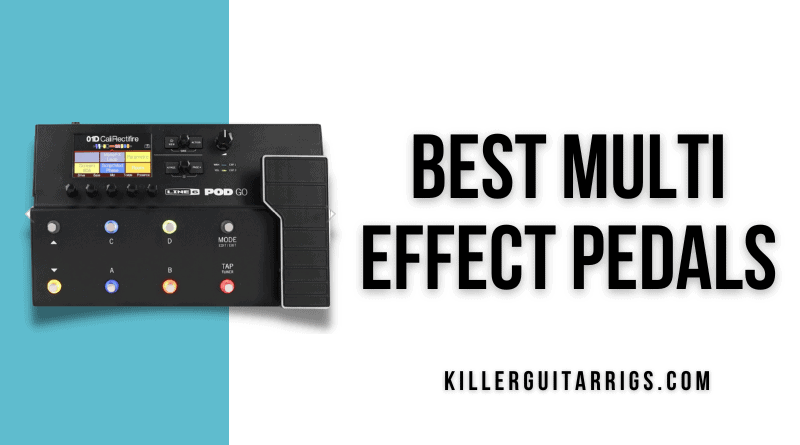Multi-effects units aren’t a new thing. What’s novel is how much better they are today than just a few years ago. Most of them offer far more than effects. From accurate amplifier simulations to high-fidelity impulse responses, many of today’s multi-effects units provide tonal accuracy, portability, and versatility.
In this KillerGuitarRigs Review, we looked at some of the best options for users of all styles and budgets. In the list below we have something for everybody, from the beginner that needs a low cost, bare-bones unit to the working musician whose main concern is quality. Keep reading to find out more.
Read more about our review process.
Contents
Our Top 3
The Line 6 Pod Go is our Top Pick. This unit draws on the very popular and highly regarded Line 6 series of multi-effects, striking an ideal balance of quality and cost. It features high-quality effects that can easily be edited through this unit’s intuitive interface.
If you’re trying to keep costs down, consider the Zoom G1x Four – our Best Budget option. It’s a great introduction into the world of multi-effect units and features a variety of effects, plus the ability to edit them at will. It is also quite portable and even features an expression pedal.
If you aren’t constrained by budget and want a high-end unit that provides maximum versatility, the Line 6 Helix LT is our Editor’s Choice. Here you get high-quality effects and models, as well as a large touchscreen for navigating the unit and editing.
Individual Reviews
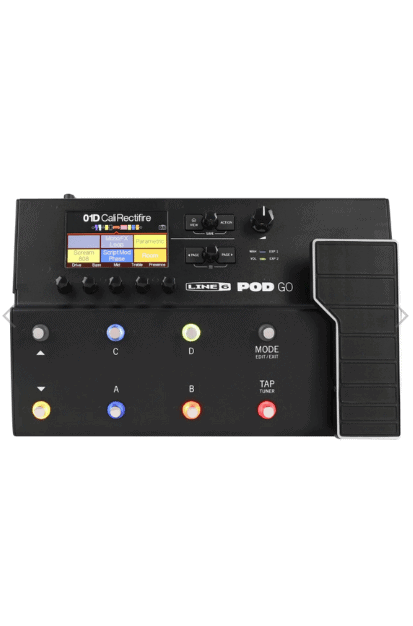
Line 6 Pod Go
The might of a modern Line 6 multi-effects unit at a fraction of the cost.
With 85 guitar and bass amplifier models, 39 cabinet sims, 16 microphone emulations, 128 user IRs and well over 210 effects, this unit is the budget version of Line 6’s modern multi-effects.
The Line 6 Pod Go features a wide array of presents, simulations, sound, and more, all with the quality we’ve come to expect from this company, but at a lower cost. This multi-effects unit is specially made for those who don’t require intricate programming capabilities, MIDI, or Variax control features, but who have a tighter budget.
We were excited to try out the Line 6 Pod Go, as this unit offers previously unimaginable quality in its price range. The first thing we noticed is that, in true Line 6 fashion, each button comes with a color ring that matches the designated effect color. This is quite helpful in instantly knowing which effect is on which button, even in environments with poor light.
With the Rotary controls, we were able to cycle through the various pages and blocks with the signal path. We were then able to adjust different settings within the blocks using the rotary encoders right below the screen.
We started by selecting a Plexi Lead amp and then used the rotary encoders to adjust the EQ just like we’d do with a normal amp. This made the user experience simpler and intuitive.
Each preset on the Line 6 POD Go featured the following blocks: wah, volume, four effects, amp/preamp, cab/IR and preset EQ. We wanted to change this order and place the preset EQ first and were able to do this easily.
Naturally, in order to keep the price so low, Line 6 had to make some compromises. Two of them include a regular LED screen (as opposed to a touchscreen on pricier Helix models) and a fair amount of plastic in their construction (instead of aluminum). That said, navigation and editing on the Pod Go were still simple and intuitive. Additionally, this unit still feels sturdy and will likely last you a long time.
Verdict: The Line 6 POD Go gives you quality virtual amps, stompboxes, cabs, and more at a great price. It’s one of the most flexible and portable options on the market and can easily slip into a gig bag or drawer when you’re not using it to keep it out of the way.
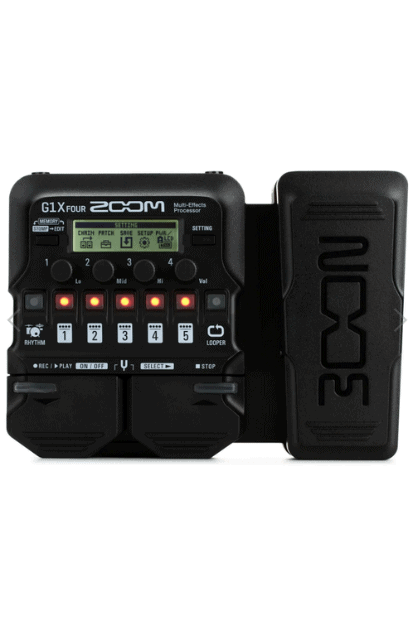
Zoom G1x Four
A variety of options for those on a tight budget.
A vast amount of effects, with loads of presets as well as user-created patches featuring instant recall, looper, and built-in drum patterns. A multi-effects unit with a very small form factor at an impressively low price.
The Zoom G1x Four is a great multi-effect unit for the beginner or those on a tighter budget. It features all the effects you’d expect in a multi-effects unit and more.
We then played through a few of their effects just to test them out. Truth be told, they sounded good for such a low price. It was especially impressive to see how many effects and features were packed into this unit for just a touch over a hundred dollars.
While the distortion patches sounded a little artificial, they were still very useable. Considering the price, we were still impressed overall. We had a great time with this unit, going through the different patches as well as jamming along to the drum patterns included in the unit.
Naturally, the quality and overall user experience cannot be compared with that of a unit that costs ten times more. But all and all, the Zoom G1x Four holds its own and is a fantastic choice for anyone looking to get started with multi-effects.
Verdict: The Zoom G1x Four is a good tool for students and folks who want plenty of effects and options with a small budget. The built-in drum patterns are a nice feature for adding some pep to your practice routines.
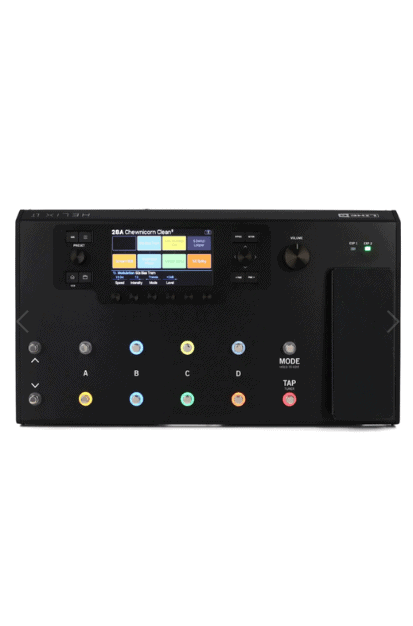
Line 6 Helix LT
A powerful multi-effects pedals with a fantastic interface.
A comprehensive and versatile multi-effects unit that also excels at modeling. Featuring all the HX models as well as the dual DSP power of the original Helix, this unit offers all of the intuitiveness and fast workflow of the Helix user interface.
The Line 6 Helix LT goes where the HX Effects doesn’t. It does so by offering amp modeling and all the processing power of the full-blown Helix, but in a smaller form factor that does away with the extensive I/O of the original.
We started by testing out how intuitive this unit really is. We hit the ground running by testing the Helix LT’s touch-sensitive screen to choose some footswitches. Here we were able to move them around at will to build the exact chain we wanted.
After creating a chain with a separate virtual stompbox for chorus, reverb, and distortion, we started playing. We were able to edit our FX with our feet without having to stop playing. This feature alone makes the Helix LT a fantastic choice for those who like to alter their tone on the go. You no longer need to bend down to move knobs with your hands.
Another great feature of this multi-effects pedal is the large 6.2″ LCD display. And yes, it is truly intuitive. We were able to have great control over the deepest editing, without even reading the manual.
It was also simple to assign patches on the front panel, as well as change banks when needed.
Truth be told, we lost track of time going through the 300 amps, cabs, mics, and effects included here, all with the well-known Helix quality. Additionally, the Helix LT includes the powerful Fractal Audio’s Axe-FX III, in case you need even more options.
Verdict: The Line 6 Helix LT powerful yet very intuitive multi-effects unit that offers fantastic modeling. This unit offers seemingly endless choices for sounds, routing, and editing, all with Helix quality. Add to that the large touchscreen for maximum ease of use and you’ve got yourself one of the best multi-effects on the market today.
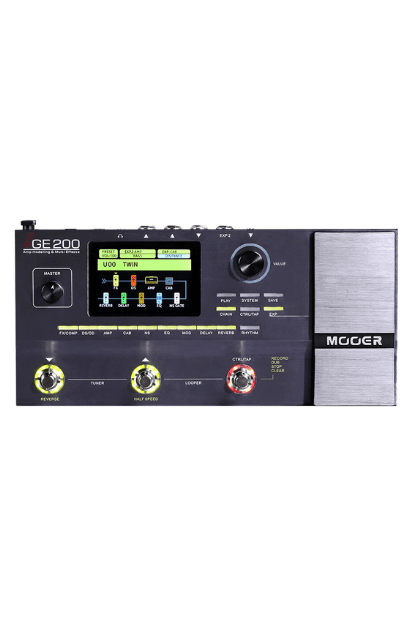
Mooer GE-200
An ideal balance of quality and cost.
The Mooer GE-200 features everything you need from a multi-effect unit at a great price point. With features like 55 amp models, 26 IR speaker cab models, 70 effects of all sorts, a 52-second looper, and more, this multi-effects processor offers comprehensive processing in a small form factor.
To begin our tests on the Mooer GE200, we went straight for the Mesa Rectifier preset, where the sound was reminiscent of that aggressiveness, sustain, and bite that this legendary amp is known for. Altering our sound was also an intuitive process and the LCD screen guided us every step of the way.
After playing through a few more presents, it became apparent that this multi-effects pedal features several high-gain tones prominently. This fact alone will serve the heavy guitarist well. Naturally, all the other expected effects are there. There are plenty of reverbs, chorus, flangers, delays, and more to choose from, as well as clean Fender amps presets as well.
Although all of the features and effects here are of good quality, the expression pedal felt a bit sluggish when we tried the wah-wah mode. That said, it does work well with the delay function as well as controlling feedback and oscillation on the fly.
It featured a quality drum machine, which we found to be very useful for practice. There were 40 different patterns and 10 different metronome rhythms to choose from, so there were beats to suit all styles.
We found the build quality of this Mooer pedal was better than expected. For a brand better known for their budget electronics, they have made a surprisingly premium-feeling unit, with solid construction and a similar look to much more expensive units.
Verdict: This multi-effects pedal offers a good price-benefit ratio. It features everything you could want in a pedal, especially if this is your first attempt at a multi-effects unit. With good built quality, tons of effects and simulations, and a simple user experience, the Mooer GE200 is a good pedal for the money.
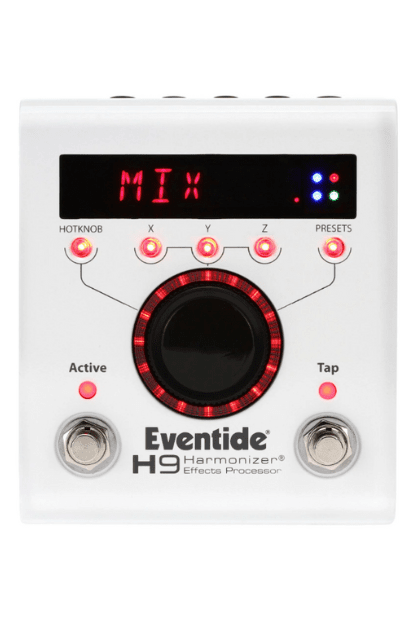
Eventide H9 Max
Ultra-compact multi-effects unit that packs a punch.
This is one of the smallest multi-effect units in the market, with a fair price. The H9 Max is commonly found in plenty of pedalboards from working musicians and is not unusual to see even two of them in a setup. This pedal offers quality and is easy to use, simple, small, and at a good price.
The Eventide H9 Max has a very small footprint and gives you a variety of sounds, including all of Eventide’s stompbox effects. These include the entirety of the 52 algorithms and known presets from TimeFactor, Space, ModFactor, and PitchFactor. Add to that Sculp, PitchFuzz, Crushstation, SpaceTime, Resonator, UltraTap Delay, and Compressor EQ. And you also get to download all future Eventide effects via the free H9 Control application on a Bluetooth-capable device.
Despite its small size, we welcomed the sight of its 99 factory presets. We went straight for the Black Hole Reverb patch. Here, we got that famous Eventide reverb and stayed there for a while, playing extended voicings and enjoying the clarity and openness of each note.
Next up, we tried the Tricera patch for a full chorus sound that fit nicely in some open chords as well as some inversions.
Our favorite distortion patch on the H9 Max was the Crushstation, with its intense bite for chugging chords and present sustain that sounded especially good on legato lines.
With the simple, one-knob user interface, we were able to navigate through patch after patch, from clean to crunch and more. We played through effects that were responsive and that could blend well in a variety of musical situations.
This came as no surprise, as the H9 Max is one of the most popular small multi-effects units on the market. Despite all the benefits this unit offers, it is a bit limited when it comes to manipulating and getting to patches quickly given its minimalistic control design.
Besides delivering quality effects and ease of use, we were able to stay in tune throughout our tests via the built-in tuner. This unit also features true bypass that leaves your sound completely unaffected.
This pedal has an ideal size for maximum convenience, to the point that you can easily fit two or more on your pedalboard setup. The H9 Max can work nicely in tandem with other stompboxes and effect units, which is another massive plus.
Verdict: The Eventide H9 Max is extremely compact and offers great sound quality, versatility, and ease of use, making it a very popular effects unit. It comes with the renowned Eventide sounds that you know and the possibility to download more effects whenever you feel like it.
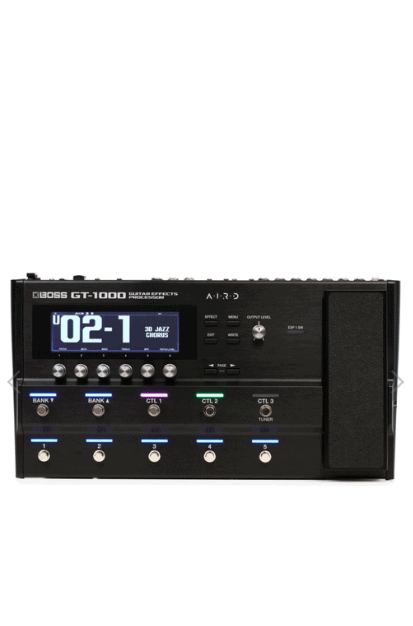
Boss GT1000
The best and most capable pedal of Boss’ famous GT line. GT-1000, This unit introduced a new concept by Boss: Augmented Impulse Response Dynamics or AIRD technology. In essence, this is a powerful processor that produces the most dynamic, responsive, nuanced, and complex sounds Boss has ever delivered.
The Boss GT-1000 is the most powerful and modern multi-effects processor in the company’s history. This unit features 32-bit AD/DA and 32-bit/96 kHz internal processing.
We fired up the GT-1000 and started going through its patches. In typical Boss fashion, you can either pick a preset or create your own user patch. So after playing through a few great-sounding presets, we tried to create our own patch.
This was a straightforward process, as we simply selected a spring reverb and a slight delay into a relatively simple patch. Naturally, you can get much more detailed than that if you wish.
To recall a patch, all we had to do was select a bank and then one of the five presets inside. And here you get quite a menu, with 250 factory patches and 250 user patches.
Boss thought of the mammoth task of keeping track of all those sounds and included a BTS editor/librarian to manage your patches smoothly. We simply went to patch mode, where the GT‑1000’s display showed us three separate screens, each with the current patch’s name and number.
Besides all the common effects known in the Boss lineage, this unit gives you models of amps like the Roland JC‑120, Marshall 1959, Fender Twin Reverb, Vox AC30m, Mesa Boogie Dual Rectifier, as well as BOSS’s Waza and Katana amplifiers to name a few. You can upload your favorite IRs via the GT‑1000 IR Loader.
One of the most impressive features on the GT-1000 is Boss’s new AIRD technology, which adds a deeper feel of realism to playing through this unit’s amplifier models. Our playing felt very dynamic and the GT-1000 was nicely responsive to our pick attacks at all times.
The only drawback to this unit is that it can feel a bit bulky at times, especially if one is looking to severely downsize a rig.
Verdict: The Boss GT1000 comes from one of the leaders in the pedal game for a reason. This unit offers fantastic features for the price, is simple to use, and comes with the decades of reputation that Boss brings to the table with their products.

Neural DSP Quad Cortex
The ultimate “you get what you pay for” multi-effects unit.
This unit goes well beyond being a multi-effects and modeler pedal. It features a wide array of sonic options, as well as three modes under which it can operate. All of this is made simpler by a 7-inch multi-touch display.
The Neural DSP Quad Cortex (full review here) is among the priciest multi-effects units on the market today. But as the motto goes, here you truly get what you pay for. Although this unit features superior quality and flexibility with a myriad of options on just about anything, it is still quite compact for what it offers.
We were excited about this ultimate gigging machine, so we started by trying out each of the three modes of operation.
We began with Preset mode. Here we were able to use the eight stomp buttons to choose one of the eight presets available per Bank. Neural included up and down stomp buttons on the design, which allows you to cycle through said Banks.
All and all, this unit comes with 256 presets. Naturally, you can also come up with your own.
Next up, we went to Scene mode. Here we got eight snapshots of one single preset. Each preset had eight versions and we were able to alter each as well as bypass effects at will. This increases the number of factory presets to 2000.
Finally, Stomp mode allowed us to really go deep into each preset. In this mode, we were able to assign a specific preset to one of the eight stomp buttons. Assignable options included amp models, individual effects, Neural Models, and IRs.
In other words, you can use the Neural DSP Quad Cortex in three different ways. Even better, you can choose one of the modes for different moments, projects, and even songs. Whatever workflow functions better for you is at your disposal here.
This unit also features an impressive 2 GHz of processing power. This allows you to come up with elaborate signal chains and still keep latency at bay. The one drawback on this unit is its price. A nearly two grand, it is an investment that may be beyond certain budgets.
Verdict: The Neural DSP Quad Cortex might be the best all-in-one solution for the working guitarist, but it is quite expensive. It features fantastic sound quality, features, versatility, and the ability to operate it basically any way you want.
How to Choose the Right Pedal For You
Multi-effects pedals have come a long way. Although they have been around for years, their quality has improved by leaps and bounds. A few years back, even thinking of replacing a carefully put-together pedalboard with a multi-effects unit suggested you didn’t really care about tone.
The basic principle was that individual stompboxes were far superior to digital units that tried to “do it all”. Twenty years ago, there was little room for debating this.
However, there have been breakthroughs in the technology employed to emulate certain sounds and effects. Besides effects, there’s been a boom in units that do a fantastic job with amp modeling and impulse responses (IR). This is not only supported by the number of successful high-end companies like Kemper and Neural that rely on this technology but also through the endorsement by some of the most revered guitarists today.
Naturally, the one aspect that has always been a massive benefit of working with a multi-effects unit still remains: you can drastically downsize your rig. And now, you can do that while still preserving your tone. This will ring very true for folks who have carried a Marshall Plexi (or Fender Twin, or Roland JC-120) up a flight of stairs. Nothing like dragging around 100 pounds of gear to give you some perspective.
Now you can have authentic models of all those amps and tons more without having to break your back, the bank, or sacrifice your tone.
The main point behind multi-effect units is convenience. After all, do you really want to haul a Mesa Rectifier for your distortions and a Fender Twin for your cleans? How about adding a Bassman to get that unique bluesy feel? Does the stage even fit one amp, let alone two or three?
In all honesty, most professionals won’t be able to pick apart the physical amp from the modeled version. This is especially true for more expensive multi-effects units.
Even though multi-effects pedals can vary greatly, you have to ask yourself two simple questions: How much do I want to spend and what do I need it for?
The needs of a hobbyist who gigs on weekends will differ from a professional whose livelihood depends on his performance. And these two will be different from the beginner’s needs. So it’s important that you think about this when determining your needs and budget.
Once you’ve answered that, you can get more specific. Is amp modeling important for you? Do you prefer a touchscreen for ultimate ease of use? Do you want just basic effects like chorus, flanger, distortion, etc, and don’t care about IRs or amp models?
This will help narrow down your list and will hopefully lead you to the very best choice of multi-effects pedal for you and your needs.
Final Thoughts
Multi-Effects units are a great way to save space and your back. With a small form factor, these units can now provide the quality you require for your specific needs. No need for patch cables, loads of space on stage, and tons of 9-Volt batteries or adaptors.
Are you a working guitarist who is willing to spend about $500 to get a solid unit that will deliver at gigs? Consider the Line Pod Go Pro, our Top Pick.
Are you a beginner who is curious about how effects work and wants to learn how to combine them, alter them, etc? Then look at the Zoom G1x Four, our Best Budget option.
On the other hand, do you want to have a fair amount of flexibility with good quality and are willing to pay the price? Then check out the Line 6 Helix LT, our Editor’s Choice.

